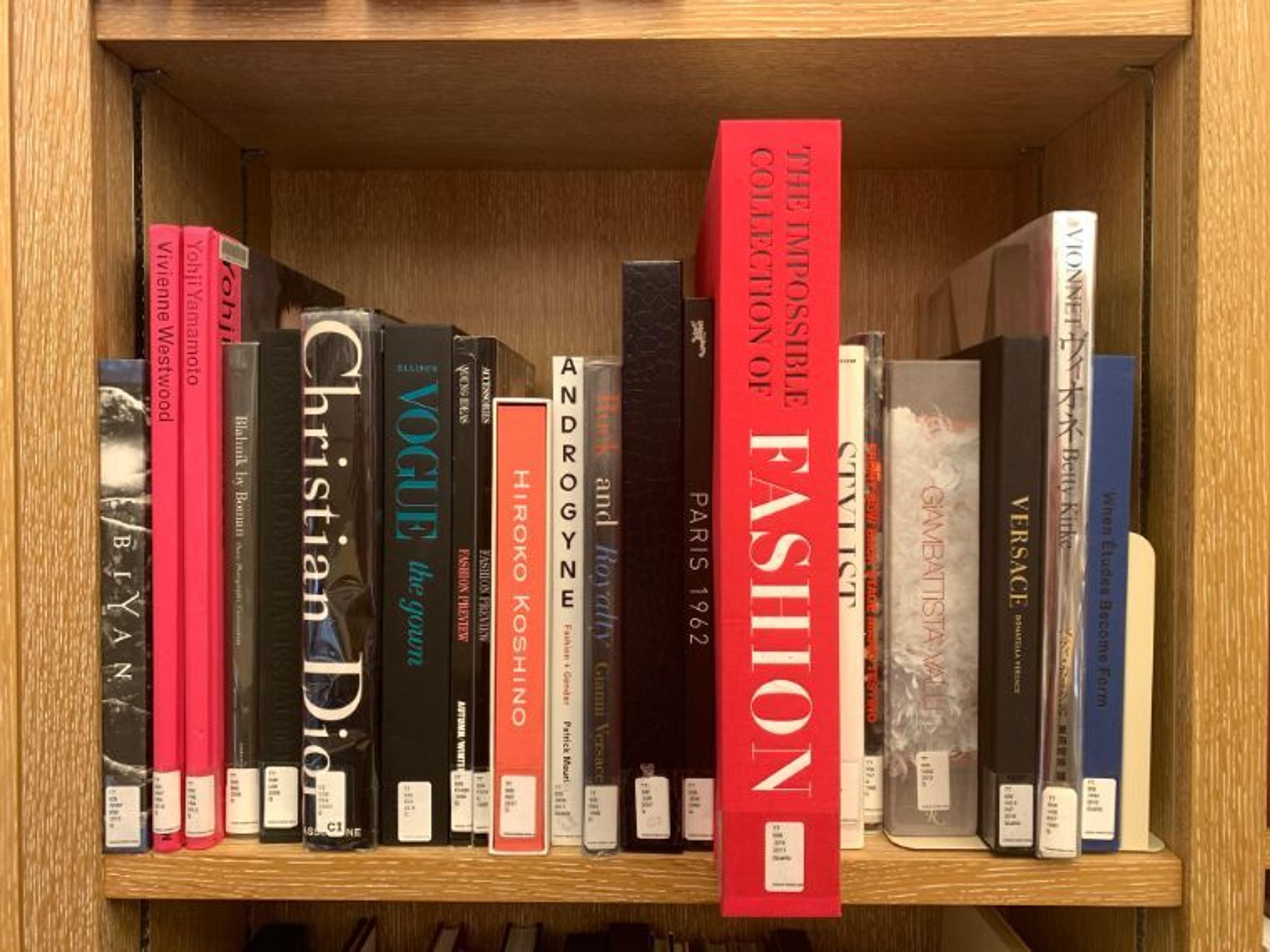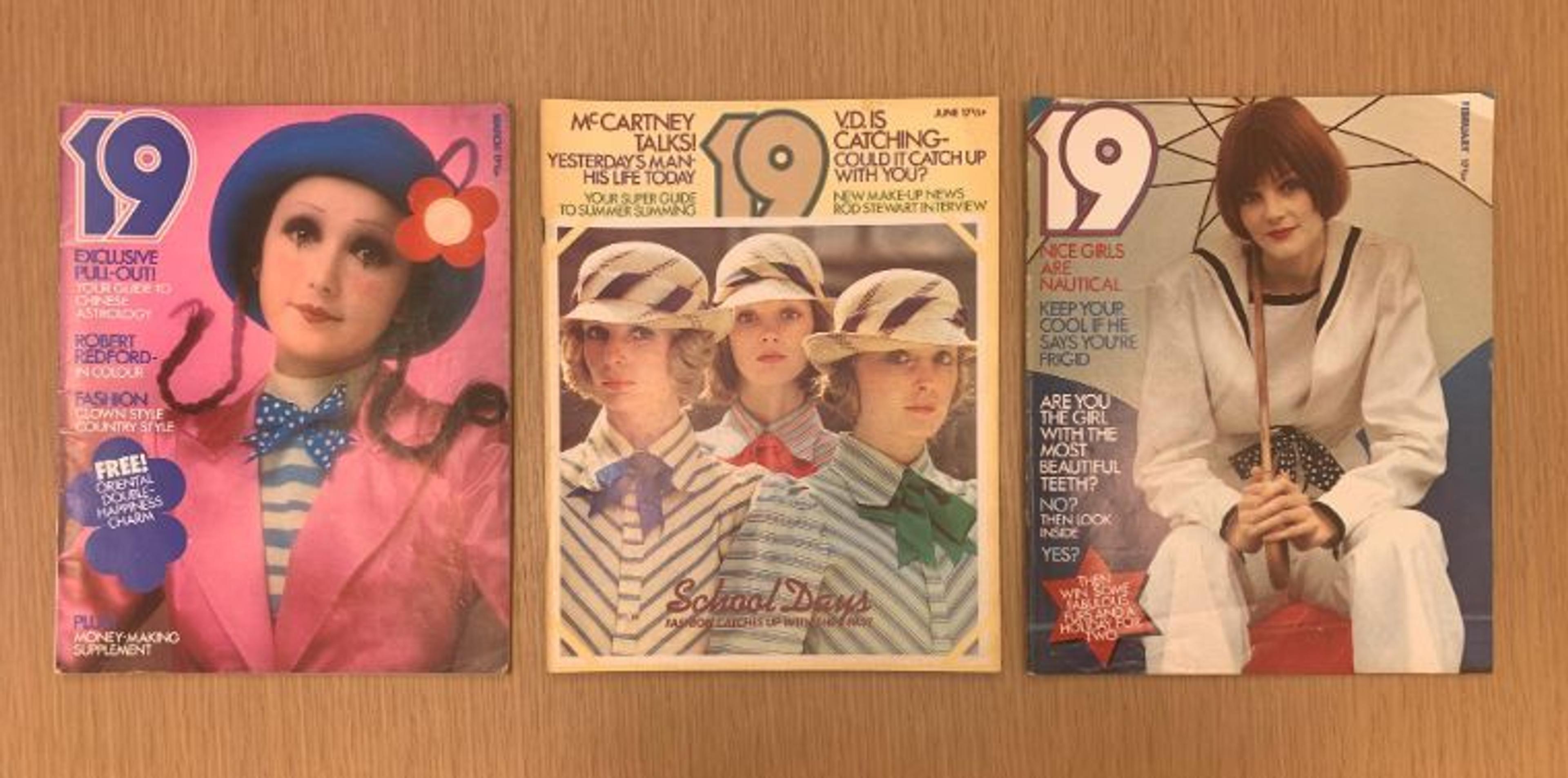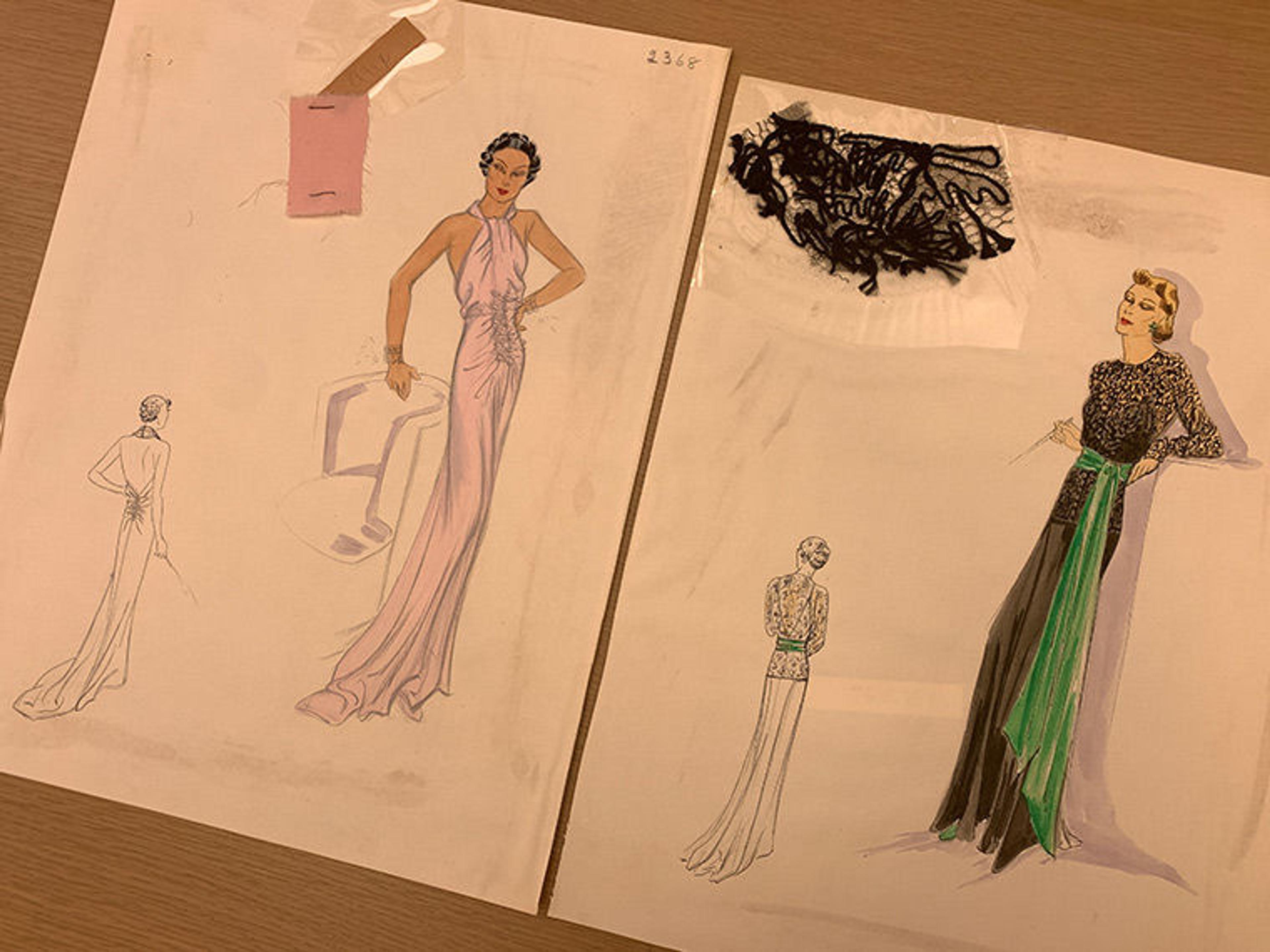
A sneak peek of the library shelves in The Irene Lewisohn Costume Reference Library. All photos by the author
The legendary fashion designer Karl Lagerfeld once said that "books are a hard-bound drug with no danger of an overdose. I am a happy victim of books." For those who share a similar addiction for all things fashion, The Costume Institute's Irene Lewisohn Costume Reference Library collection is an endless well of inspiration with over thirty thousand volumes related to the history of fashion and dress. In addition to books and periodicals, there are over fifteen hundred designer files and extensive special collections materials which include artist books, exhibition history documentation, designer archives, fashion plates, lookbooks, photography collections, scrapbooks, sketches, textiles samples, and related fashion ephemera.
Access and Users
The Irene Lewisohn Costume Reference Library (more commonly known as The Costume Institute Library) is primarily intended for research relating to exhibitions and publications by the curatorial staff, but there are multiple access points for others to interact with this specialized museum library collection. Located within The Costume Institute department, limited appointments are available for outside and qualified researchers, based on the librarian's discretion and availability. Materials from The Costume Institute Library may also be requested via Watsonline and viewed in Thomas J. Watson Library (where no appointment is necessary) or for use by outside institutions through Interlibrary Loan. A glimpse inside the collection is also shared almost daily on Instagram, @costumeinsititutelibrary, and digitized images of fashion ephemera and rare materials are available on Watson Library's Digital Collections and Pinterest.
The outside researchers who use this library are a lively group of creatives working mainly in the fashion, film, and television industries including (in no particular order), fashion designers, historians, shoe designers, accessory designers, leather designers, eyewear designers, filmmakers, interior designers, costume designers, fashion stylists, art/creative directors, graphic designers, photographers, artists, illustrators, toy designers, actors/actresses, musicians, florists, nail artists, fashion editors, fashion writers, and even one candy artist.

Photographer Shaniqwa Jarvis
Library Collection Development
Overall, The Costume Institute's Library aims to represent the valued diversity and interdisciplinary nature of fashion. As detailed in Celia Hartmann's recent post, this library collection began with a number of significant gifts by donors, curators, and staff, and we are so grateful that all of that generosity continues to the present day. The library collection also grew through purchases and largely reflects the scope of The Costume Institute Collection holdings of clothing and accessories. In addition, for every department exhibition or scholarly project, new books and materials are acquired to support the preliminary research phase which at many times fall outside fashion-specific topics such as: art, film, gender studies, LGTBQIA+ history, literature, music, pop culture, subcultures, and others. It is important to note that the library collects reference materials about all types of clothing, fashion, related topics, and even different formats of materials not currently nor generally acquired for The Costume Institute Collection. Since our library also serves the public, the research interests of our patrons also influence the various types and topics of our library purchases.
Collection Highlights and Recent Acquisitions
Last summer, we received our second largest designer archive in The Costume Institute Library from the beloved and multi-talented Todd Oldham, who generously donated his incredible fashion and design archive records. The different types of fashion ephemera Oldham donated include videotapes, photographs, lookbooks, fabric samples, scrapbooks, and publicity materials that reflect the designer's career while also capturing the zeitgeist of the 1990s. Below are some Polaroids from runway show fittings with recognizable 1990s supermodels of that time period.

Todd Oldham fitting polaroids from the 1990s
Another new treasure we acquired (made possible by the Friends of The Costume Institute fund) is a three-volume set of Thomas Uwin's original nineteenth-century fashion illustrations that were published in Rudolph Ackermann's Repository for the Arts magazine from 1809 through 1828.

Thomas Unwins, Female Costume: Original Drawings (London, England? : Ackermann's Repository of Arts?, 1828?)
Lookbooks, which are essentially catalogues with images of a designer's or design house's collection per season (intended for marketing purposes), are one of the more popular reference materials requested by our patrons. A keyword search in Watsonline reveals over seventy sub-collections and over one thousand volumes. These materials are mainly housed in archival boxes by lookbook size or format. Below are some favorites from Comme des Garçons, Versace, and Yves Saint Laurent.

Comme des Garçons lookbooks from the late 1970s

Gianni Versace Spring-Summer 1993 lookbook

Yves Saint Laurent Rive Gauche Spring 1988 binder of runway photographs
"Street style" is a topic that covers a wide range of demographics and subcultures. A search in our catalog uncovers many books that focus on how everyday people dress by city worldwide. We also have two complete periodical runs that visually catalog women's and men's Japanese fashions of the late 1990s and 2000s: Fruits and Tunes magazines photographed by Shoichi Aoki. Furthermore, we have many photography books that cross over into this category from photographers such as the late Bill Cunningham and Jamal Shabazz, both of whom have documented the nostalgia and spirit of New York City, and many more.

Early issues of Fruits magazines
No. 3 2004 issue of Tune magazine

Bill Cunningham, Bill Cunningham's On the Street: 60 Iconic Years of Fashion Photography (New York: Clarkson Potter, 2019)

Jamel Shabazz, Sights in the City : New York Street Photographs (Bologna: Damiani, 2017)
For early fashion photography, we have an incredible group of black and white photos of French fashions from 1895 through 1915 created by well-established photography studios, including Talbot, Reutlinger, Felix, and Henri Manuel, that are part of the library's Digital Collections.

Examples of women's wear from the French Fashions, 1898–1915 digital photograph collection
For the popular subject areas of "teen fashions" and "youth culture," we have a complete run of a British teen magazine called 19, in addition to other well-recognized American titles such as Sassyand Seventeen magazines.

19 magazine covers from the 1960s-1970s
A noteworthy trend is the popularity of streetwear and its crossover into high fashion. The library has a growing collection of books on this topic which includes sneaker culture and accessories. The images below are from an annual series called All Gone: The Finest in Street Culture, which catalogs the best and most sought after items in street culture for one particular year (we have issues from 2011 through 2018).

All Gone: The Finest of Street Culture 2012 ([Paris] : La MJC, 2012)
The design and use of fabric in clothing and fashion is another interesting area of study that entails tactile research. The Met has a separate library dedicated to textiles called the Antonio Ratti Textile Center and Reference Library, but we also have a number of catalogs and sketches with accompanying fabric swatches that range from workwear uniforms to evening gowns.

Some examples of 1930s Jay Thorpe fashion sketches with textile swatches
The range of research materials in a fashion library collection goes from scholarly in nature to highly visual coffee table type books to smaller, independent publications such as zines. Some examples of limited-edition art publications we have in our collection include the popular title Fashion Is Nuts, a book documenting walnut art in the likeness of fashion icons created by the artist Donald Robertson. Another personal favorite, called Indigenous Woman, is an artist magazine that is—from the advertorials to the fashion editorials to graphic design and even product design—entirely executed by the artist Martine Gutierrez. In the artist's own words, the artistic theme of their publication is "the celebration of Mayan Indian heritage, the navigation of contemporary indigeneity, and the ever-evolving self-image."

Donald Robertson, Fashion Is Nuts: A Donald Robertson/Henry Leutwyler Conspiracy (Iceland: Oddi Printing, 2015)

Martine Gutierrez, Indigenous Woman (New York: Ryan Lee Gallery LLC, 2018)
Fashion reference materials come in many shapes and styles. We have a complete collection of New York City based publication Visionaire that playfully blurs the line between a periodical and artist book. Each issue has a different theme, cast of collaborators, but also varying formats. One example we love to pull out for a show-and-tell is Visionaire 44: Toys, which is a box of Kidrobot brand dolls (with accessories such as a camera or martini glass) designed by different designers or design houses.

Visionaire no. 44: Toys (New York: Visionaire Publishing, 2005)
Other fun and surprising objects that are not in a traditional book format include an extraordinary eighteenth-century Dutch fashion card game and an Issey Miyake 45th Anniversary wooden "sushi box" filled with small accessories in signature pleated fabrics.

Miyake Design Studio, 45th Anniversary (1995)
Primary resource materials in fashion research include studying popular magazines. The library holdings include a wide range of mainstream fashion magazines and journals in print form as well as e-resources such as Vogue Archive, Harper's Bazaar Archive, and Women's Wear Daily Archive (all are available onsite at Watson and Nolen libraries). The library also collects rare, niche, hard-to-find, or short-lived magazines, and many others in-between, as seen in the image below.

A selection of fashion-related magazines from The Costume Institute's Library collection: Rags, Vue, Egoïste, Ritz Newspaper, The Manipulator, Interview, Sassy, East Village Eye, Hanatsubaki, Me, Love, Supreme,i-D, Jill, Cheapdate, The Face, and Hi Fashion
All of these examples provide only a tiny glimpse of what a fashion library looks like in a museum collection. Materials from our library can be requested and viewed in Thomas J. Watson Library. Additional information about The Irene Lewisohn Costume Reference Library, archives, and special collections can be found on our website page here. For more updates on new acquisitions and more examples of what is inside our fashion library, please follow us on Instagram @costumeinsititutelibrary and check out these hashtags: #CILPeriodicals, #CILSpecialCollections, #CILLookbooks, and #CILDigitalCollections.

